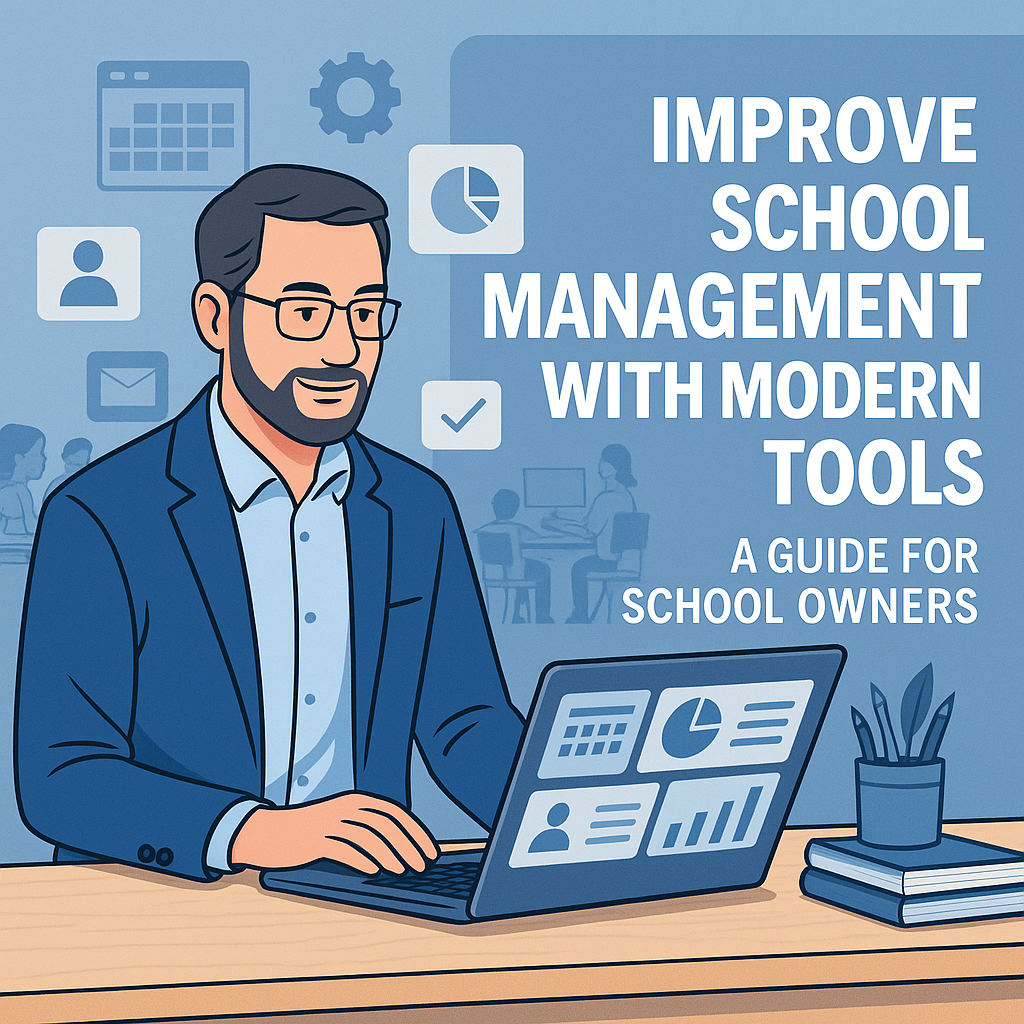How to Improve School Management with Modern Tools: A Guide for School Owners

In today’s competitive and fast-changing educational landscape, managing a school is no longer just about handling academics and paperwork. It’s about creating a smooth, efficient, and transparent system that keeps students thriving, teachers empowered, parents informed—and your operations running like a well-oiled machine.
As a school owner, you understand the pressure to deliver excellence across academics, administration, and communication. But how do you achieve that without being overwhelmed?
The answer lies in modern school management tools—smart, digital solutions designed to help you streamline tasks, reduce manual errors, and make data-driven decisions with confidence.
In this guide, we’ll explore how these tools can transform your school management, what to look for when choosing them, and how to implement them successfully.
Why School Owners Must Embrace Modern Management Tools
Let’s face it: Traditional school management systems—think paper registers, Excel spreadsheets, and disconnected communication—are no longer sufficient.
Parents expect real-time updates. Teachers need smart grading systems. Administrators want easier access to student data. And you, as a school owner, need to track everything from finances to faculty performance—often across multiple campuses.
Modern school management tools address these challenges by offering:
- Centralized control
- Automation of time-consuming tasks
- Transparency and real-time data
- Enhanced communication between all stakeholders
The result? Increased operational efficiency, better educational outcomes, and a stronger reputation for your institution.
Common Challenges Faced by School Owners in Management
Before diving into solutions, it’s important to recognize the key pain points school owners commonly face:
- Fragmented systems: Separate platforms for attendance, fee collection, communication, and academic records lead to inefficiencies and data loss.
- Manual processes: Tasks like report generation or admission tracking are time-consuming and prone to human error.
- Poor parent engagement: Lack of timely updates frustrates parents and lowers satisfaction.
- Limited data insights: Without real-time reporting, it’s hard to make informed decisions about staff performance, student progress, or budgeting.
- Compliance issues: Staying aligned with local education board guidelines and policies can be tricky without a proper system.
These challenges don’t just cause frustration—they affect your school’s growth and profitability.
Core Features of Modern School Management Tools
Smart school owners are investing in cloud-based, integrated management platforms that handle all administrative tasks in one place. Here are the core features to look for:
1. Automated Attendance & Scheduling
Marking attendance via apps or biometric systems reduces manual errors and saves time. Schedules for classes, exams, and activities can be managed seamlessly.
2. Student Information System (SIS)
Maintain complete academic records, behavioral notes, medical history, and more—all accessible with a click.
3. Fee Management
Track dues, automate reminders, enable online payments, and generate reports. This feature reduces late payments and improves cash flow.
4. Parent-Teacher Communication Portals
Mobile apps or SMS/email systems to keep parents informed about student progress, attendance, homework, and school events.
5. Online Admissions & Enrollment
From form submission to document uploads and status tracking—manage the entire process digitally.
6. Real-Time Dashboards & Analytics
Get insights into performance metrics, fee collections, teacher workload, and student performance instantly.
By using a single tool or a unified platform, you create a seamless ecosystem where data flows effortlessly between departments.
How These Tools Improve School Management
When implemented correctly, school management tools offer measurable benefits:
- Reduced Admin Load: Staff can focus on high-value tasks instead of manual paperwork.
- Better Decision-Making: Real-time analytics help you make informed strategic decisions.
- Enhanced Parent Satisfaction: Parents stay informed, leading to stronger trust and retention.
- Higher Staff Productivity: Automated processes reduce burnout and errors.
- Improved Student Outcomes: With better tracking and communication, learning improves.
The ultimate benefit? Peace of mind and long-term scalability.
Choosing the Right School Management Software: A Checklist for School Owners
Not all tools are created equal. Here’s what to look for:
- Scalability: Can it grow with your school? Multi-campus support is a bonus.
- Cloud-Based Access: Enables anytime, anywhere access for admins, staff, and parents.
- User-Friendly Interface: Your team should be able to learn it quickly.
- Mobile App Support: Essential for parent-teacher communication.
- Customization: Adaptable to your school’s specific workflow.
- Data Security: Must include encryption and compliance with local education data laws.
- Integration Capabilities: Works well with other platforms like LMS, payment gateways, or HR tools.
- Local Support and Training: Having access to training and after-sales support is crucial.
Pro Tip: Always request a demo or pilot before investing fully.
Conclusion
As a school owner, your role isn’t just to manage—it’s to lead. By adopting modern tools, you’re not just solving today’s problems, you’re preparing for tomorrow’s opportunities.
Modern school management isn’t about technology for technology’s sake—it’s about creating a stronger, smarter, and more scalable educational institution that can thrive in a digital world.





